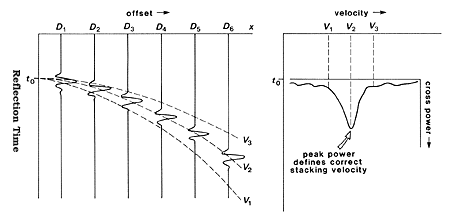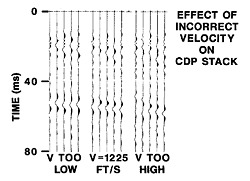|
Imagine recording four seismic traces from one source (top panel, right).
If we plot the travel time for a seismic signal as a function of distance
between receiver and source we see that time increases (middle panel).
The curve through the traces forms a hyperbola (details are in a subsequent
page).
For horizontal flat surfaces, the change in travel time for a set of increasing
sourcce-receiver spacings of a CMP gather (bottom panel) will be identical
to the "common shot gather" (top panel). The travel time curve from the
reflector will appear approximately as a hyperbola. Unlike for the common
shot gather, in the CMP gather all of the arrivals correspond to the same
reflection point.
The hyperbolic representation for the travel time curve is exact if the
velocity above the reflector is constant, and if the reflector is flat.
For layered media we saw that the travel time curve was hyperbolic, but
the velocity used should be the RMS velocity. Unfortunately we don't know
what this velocity is, so we attempt to estimate it from the data themselves.
We proceed as follows.
- Assume that each reflection event in a CMP gather has a travel time
that corresponds to a hyperbola,

where Vst is a "stacking" velocity, or sometimes called the Normal Moveout Velocity,
Vnmo.
- For each reflection event hyperbola, perform a velocity analysis to
find Vst. This is done by first choosing to. Then
choose a trial value of velocity v1. The associated travel
time hyperbola is generated and it forms a tragectory on the CMP gather.
Sum the energy of the seismic traces along the trajectory and plot this
value on a graph of velocity versus energy. Repeat this procedure for
different trial velocities. Choose as Vst, the velocity that
yields the largest energy. In the diagram below v2 represents the stacking
velocity. The term cross power can be interpreted as total energy.
 From Kearey, Philip and Micheal Brooks, An
Introduction to Geophysical Exploration. 2nd ed. Blackwell
Science: 1991.
From Kearey, Philip and Micheal Brooks, An
Introduction to Geophysical Exploration. 2nd ed. Blackwell
Science: 1991. |
- Calculate the Normal Moveout Correction:
Again, using the hyperbolia corresponding to Vst, compute the
normal moveout for each trace and then adjust the reflection time by the
amount DT.

4. Finally, stacking the normal moveout corrected traces generates
a single trace. Each trace corresponds to a zero-offset trace, that is,
the seismic trace that would have been recorded by a receiver
that is coincident with the source.
As an example consider the two CMP gathers in the figure below left (click
for a larger version). The most prominent seismic wavelet at times between 50 and 70
ms is a bedrock reflection from about 9 m below the surface. The
geophone offsets were 3.7 m (12 ft) for the nearest traces and 17
m (56 ft) for the farthest trace with 1.22 m (4 ft) between geophones. The
reflection even of interest is at about 55 msec.
In the figure above right, the CMP gather for point 988 has been moveout corrected
using different velocites. The moveout correction using a velocity of 1225
ft/s (328 m/s) causes the reflection events to occur at about the same time
for all traces. Stacking these signals will produce a high quality reflection
signal. Conversely, a velocity of 1075 ft/s is too small and produces too large
a correction at far offsets.
 To
show what happens if the wrong velocity is choosen for carrying out the normal
moveout correction, five 12-fold CMP traces are shown (right) processed with
three different velocities. When the velocity is too low, the frequency of
the reflection wavelet is lowered and it is therefore depicted too shallow
on the seismic section. When the velocity is too high the frequency dereases
and the reflection wavelet is depicted at too large a time on the seismic section.
The correct velocity gives the correct position for the wavelet and preserves
the high frequencies which allow best resolution of small features and thin
beds. Correct velocity is about 373 m/s (1225 ft/s). To
show what happens if the wrong velocity is choosen for carrying out the normal
moveout correction, five 12-fold CMP traces are shown (right) processed with
three different velocities. When the velocity is too low, the frequency of
the reflection wavelet is lowered and it is therefore depicted too shallow
on the seismic section. When the velocity is too high the frequency dereases
and the reflection wavelet is depicted at too large a time on the seismic section.
The correct velocity gives the correct position for the wavelet and preserves
the high frequencies which allow best resolution of small features and thin
beds. Correct velocity is about 373 m/s (1225 ft/s).
© UBC EOS, D.W. Oldenburg and F. Jones
|

